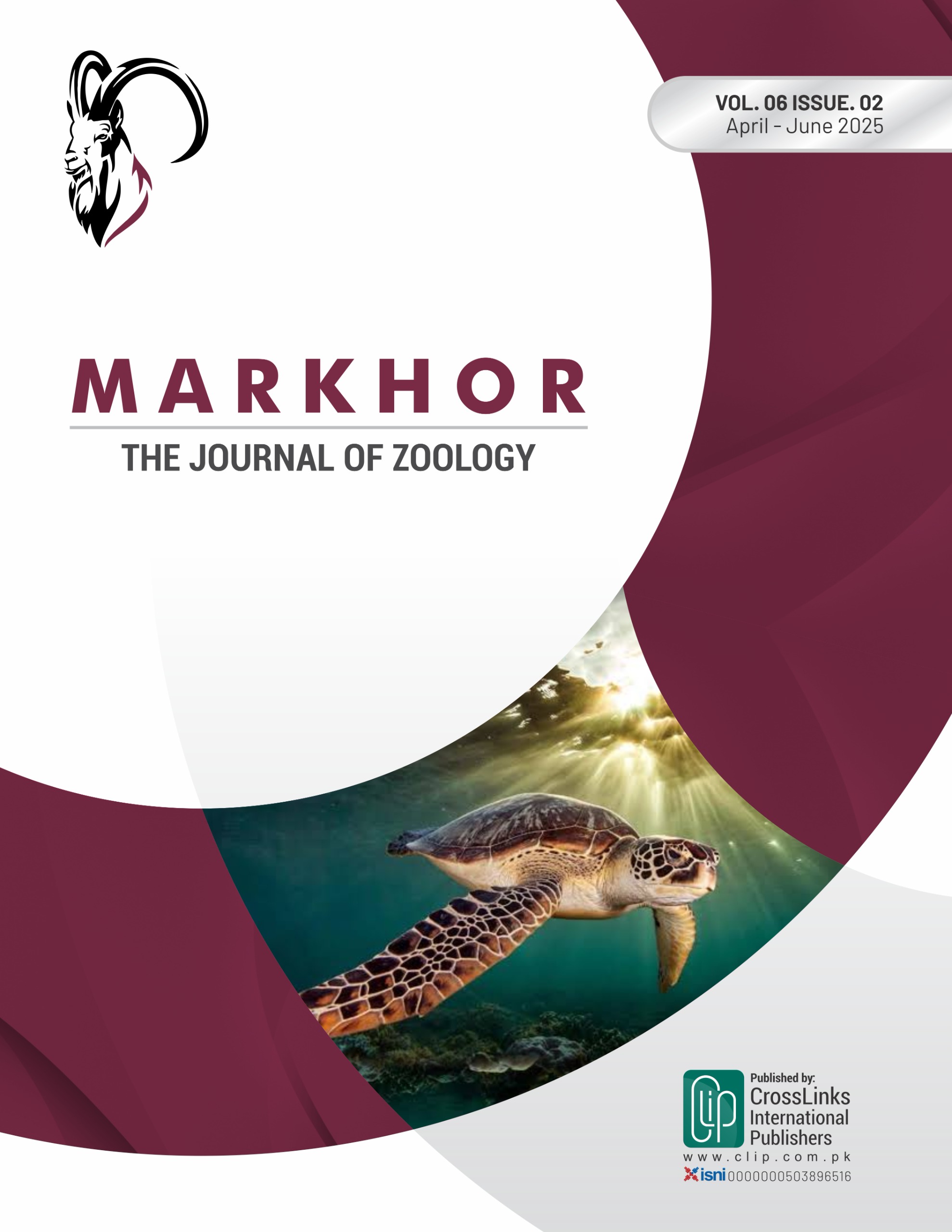Comparison of Avian Niche Communities between Agricultural and Peri-urban Landscapes of Nankana Sahib and Hafizabad
Avian Niche Communities between Agricultural and Peri-urban Landscapes
DOI:
https://doi.org/10.54393/mjz.v6i2.189Keywords:
Avian Diversity, Nankana Sahib, Hafizabad, Agricultural Land, Peri-Urban, AvifaunaAbstract
This comparative field study was conducted in the Nankana Sahib and Hafizabad districts in Punjab, Pakistan, between October 2024 and January 2025. Objectives: To study the avian community structure in both agricultural and peri-urban environments to determine the impact of land-use changes on biodiversity. Methods: The surveys were conducted during dawn and dusk. The point count method was employed to record avian diversity. Results: Systematic surveys provided the records of thirty-two avian species that belonged to ten orders and twenty-four families, Passeriformes being the most numerically dominant taxonomic group. Compared to the monocultural agricultural settings of Hafizabad (Shannon Wiener=2.881; Simpson=0.918), Nankana Sahib, a peri-urban heterogeneous setting, had a greater richness of species and a higher diversity index (Shannon Wiener=3.078; Simpson=0.936). Functional guild analysis revealed that Nankana Sahib has a higher guild structure that includes nectarivores and omnivores, and Hafizabad has an insectivore and granivore composition, presumably due to intensive farming activities. The low Pearson correlation (r = 0.177) of the two sites reflects the unequal community structures, which can be explained by the unequal land-use regimes. Conclusions: The results thus indicate the ecological trade-offs of urbanization and agricultural intensification, and the need to conserve sites specific to avian biodiversity, i.e., restore habitat, use less pesticides, and maintain ecosystem services in the agroecosystems of Punjab.
References
Raza H, Mehmood S, Khan BN, Bibi F, Ali Z. Avian Diversity of Lahore Zoo Safari in Winter Season Lahore, Pakistan. Journal of Animal & Plant Sciences. 2015 Jan; 25(3): 378-81.
Mekonen S. Birds as Biodiversity and Environmental Indicator. Indicator. 2017; 7(21): 28-34.
Fraixedas S, Lindén A, Piha M, Cabeza M, Gregory R, Lehikoinen A. A State-of-the-Art Review on Birds as Indicators of Biodiversity: Advances, Challenges, and Future Directions. Ecological Indicators. 2020 Nov; 118: 106728. doi: 10.1016/j.ecolind.2020.106728.
Khaliq I, Biber M, Bowler DE, Hof C. Global Change Impacts on Bird Biodiversity in South Asia: Potential Effects of Future Land-Use and Climate Change on Avian Species Richness in Pakistan. PeerJ. 2023 Oct; 11: e16212. doi: 10.7717/peerj.16212.
Altaf M, Javid A, Khan AM, Khan MS, Umair M, Ali Z. Anthropogenic Impact on the Distribution of the Birds in the Tropical Thorn Forest, Punjab, Pakistan. Journal of Asia-Pacific Biodiversity. 2018 Jun; 11(2): 229-36. doi: 10.1016/j.japb.2018.03.001.
Naz S, Habib SS, Arshad M, Majeed S, Mohany M. Seasonal Trends in Heavy Metal Pollution and Water Quality in the Chashma (Indus River, Pakistan): A Study on Environmental Health Risks. Water, Air, & Soil Pollution. 2025 Oct; 236(10): 670. doi: 10.1007/s11270-025-08317-z.
Haider MZ, Ahmed S, Sial N, Afzal G, Riaz A, Asif AR et al. Avian Diversity and Abundance of Taunsa Barrage Ramsar Site in Punjab, Pakistan. Journal of Zoological Systematics and Evolutionary Research. 2022; 2022(1): 4736195. doi: 10.1155/2022/4736195.
Kumar P and Sahu S. Composition, Diversity and Foraging Guilds of Avifauna in Agricultural Landscapes in Panipat, Haryana, India. Journal of Threatened Taxa. 2020 Jan; 12(1): 15140-53. doi: 10.11609/jott.5267.12.1.15140-15153.
Mariyappan M, Rajendran M, Velu S, Johnson AD, Dinesh GK, Solaimuthu K et al. Ecological Role and Ecosystem Services of Birds: A Review. International Journal of Environment and Climate Change. 2023; 13(6): 76-87. doi: 10.9734/ijecc/2023/v13i61800.
Deng GT and Yimam IA. Ecosystem Roles of Birds: A Review on Birds’ Conservation Insight. International Journal of Zoology and Animal Biology. 2020; 3(4): 1-7. doi: 10.23880/IZAB-16000236.
Pakistan Almanac. Flora and Fauna; Punjab Province [Internet]. Pakistan Almanac. [cited 2025 Sep 27]. https://pakistanalmanac.com/punjab-flora-and-fauna.
Umar M, Hussain M, Murtaza G, Shaheen FA, Zafar F. Ecological Concerns of Migratory Birds in Pakistan: A Review. Punjab University Journal of Zoology. 2018; 33(1): 69-76. doi: 10.17582/pujz/2018.33.1.69.76.
LatLong.net. Where is Nankana Sahib, Pakistan on Map Lat Long Coordinates [Internet]. LatLong.net; [cited 2025 Sep 27]. https://www.latlong.net/place/nankana-sahib-pakistan-11189.html.
Rebi A, Wang G, Flynn T, Hussain A, Ejaz I, Afzal A et al. Harvesting Nature’s Treasure: Examining Soil Properties and Nutrient Bounty in the Crop Fields of Hafizabad, Punjab, Pakistan Using Geostatistical Kriging. Pol J Environ Study. 2025; 20(10). 1–14. doi: 10.15244/pjoes/192363.
Hall G. Assessment of Avian Community Structure and Habitat Connectivity in the Fanno Creek Corridor Bird Surveys, Habitat Assessment, and Management Recommendations. 2024.
Ding Z, Liang J, Hu Y, Zhou Z, Sun H, Liu L et al. Different Responses of Avian Feeding Guilds to Spatial and Environmental Factors Across an Elevation Gradient in the Central Himalaya. Ecology and Evolution. 2019 Apr; 9(7): 4116-28. doi: 10.1002/ece3.5040.
Lin MM, Fuller RA, Kwon IK, Lee K, Chan S, Qiu W et al. Down Listing and Recovery of Species Assessed by the IUCN. Conservation Biology. 2025 Jul: e70103. doi: 10.1111/cobi.70103.
Khan M, Israr H, Fatima K, Laraib T, Batool S, Ayoub H . Analysis of Avian Communities Under Different Urban Habitats in District Layyah, Punjab. Pakistan. Journal of Wildlife and Ecology. 2024; 8: 1-4.
Thind SK, Kumar C, Kaleka AS. Diversity and Abundance of Avifauna in Terrestrial Habitats of Ludhiana District in Punjab, India. ZOO'S PRINT. 2023 Nov; 38(11): 29-36.
Sial MA. Ornithofauna Diversity of Tehsil Pakpattan, Punjab, Pakistan. Journal of Bioresource Management. 2024; 11(1): 13. doi: 10.11648/j.eeb.20240901.13.
Downloads
Published
How to Cite
Issue
Section
License
Copyright (c) 2025 MARKHOR (The Journal of Zoology)

This work is licensed under a Creative Commons Attribution 4.0 International License.
This is an open-access journal and all the published articles / items are distributed under the terms of the Creative Commons Attribution License, which permits unrestricted use, distribution, and reproduction in any medium, provided the original author and source are credited. For comments editor@markhorjournal.com











